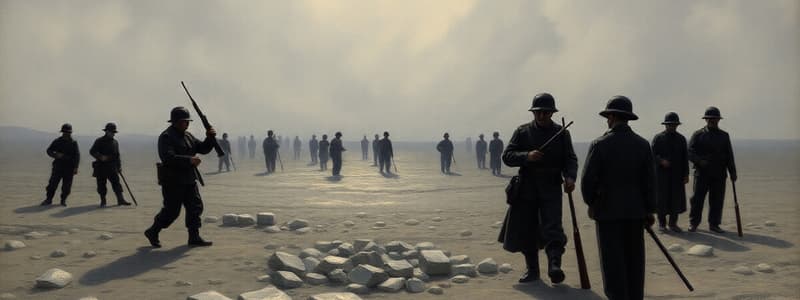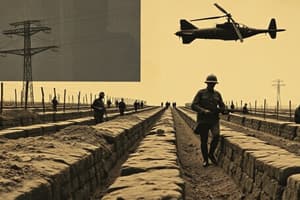Podcast
Questions and Answers
What was a key role of barbed wire in trench warfare?
What was a key role of barbed wire in trench warfare?
- To facilitate quick troop movements
- To impede enemy advances (correct)
- To provide cover for soldiers
- To serve as communication lines
How did the introduction of machine guns impact infantry tactics?
How did the introduction of machine guns impact infantry tactics?
- They led to a defensive posture in warfare (correct)
- They allowed for more aggressive cavalry charges
- They decreased the need for artillery support
- They improved troop mobility
In which situations were flamethrowers primarily used during the war?
In which situations were flamethrowers primarily used during the war?
- As a primary weapon in urban combat
- In niche offensive maneuvers (correct)
- To assist in trench construction
- For defensive perimeter safety
What was the primary benefit of telegraph systems during wartime?
What was the primary benefit of telegraph systems during wartime?
Which item significantly contributed to the static nature of trench warfare?
Which item significantly contributed to the static nature of trench warfare?
What role did tanks play in World War I?
What role did tanks play in World War I?
Which weapon was first deployed by the Germans and caused significant casualties?
Which weapon was first deployed by the Germans and caused significant casualties?
What was a major logistical challenge faced by armies regarding ammunition during the war?
What was a major logistical challenge faced by armies regarding ammunition during the war?
What impact did submarines have on naval warfare during World War I?
What impact did submarines have on naval warfare during World War I?
What was a common issue with the use of poison gas during the war?
What was a common issue with the use of poison gas during the war?
What was the initial purpose of aircraft during World War I?
What was the initial purpose of aircraft during World War I?
What essential supplies were heavily produced to deal with casualties in World War I?
What essential supplies were heavily produced to deal with casualties in World War I?
What materials were crucial for breaching trenches during World War I?
What materials were crucial for breaching trenches during World War I?
Flashcards
Machine guns
Machine guns
Machine guns allowed for rapid and sustained fire, causing heavy infantry losses and contributing to trench warfare's stalemates.
Artillery
Artillery
Heavy artillery, from field guns to siege guns, were crucial for shelling trenches and fortifications.
Tanks
Tanks
Tanks, initially unreliable, were designed to break through enemy lines. However, early challenges included mechanical failures and difficulty traversing terrain.
Poison gas
Poison gas
Signup and view all the flashcards
Aircraft
Aircraft
Signup and view all the flashcards
Submarines
Submarines
Signup and view all the flashcards
Ammunition and Explosives
Ammunition and Explosives
Signup and view all the flashcards
Food, Clothing, and Medical Supplies
Food, Clothing, and Medical Supplies
Signup and view all the flashcards
Trench Warfare
Trench Warfare
Signup and view all the flashcards
Barbed Wire
Barbed Wire
Signup and view all the flashcards
Flamethrower
Flamethrower
Signup and view all the flashcards
Communications in Warfare
Communications in Warfare
Signup and view all the flashcards
Study Notes
Weapons and Technologies
- Machine guns: Devastating weapons enabling rapid and sustained fire, causing significant infantry losses and contributing to trench warfare's stalemate.
- Artillery: Heavy artillery pieces were crucial in shelling trenches and fortifications, increasing the war's destructive potential.
- Tanks: Introduced by the British, tanks initially unreliable, but gradually improved, becoming significant in breaking through entrenched lines. Early effectiveness limited by mechanical failures and terrain.
- Poison gas: First deployed by the Germans, chlorine gas and mustard gas caused horrific casualties, leading to gas masks and new defense strategies. Gas attacks unpredictable and affected both sides.
- Aircraft: Initially for reconnaissance, use expanded to dogfights, bombing, and aerial photography. Early aircraft rudimentary, with limited range and payload.
- Submarines: U-boats (German submarines) revolutionized naval warfare, posing a significant threat to Allied shipping and impacting the war effort. Effectiveness hampered by detection and countermeasures.
Ammunition and Supplies
- Bullets and shells: Vast quantities of ammunition were required, stretching industrial capacity and supply chains.
- Explosives: Dynamite and high explosives formed a crucial part of artillery and combat, essential for breaching trenches and fortifications.
- Medical supplies: Massive production of bandages, antiseptic, and other medical supplies was required due to the scale of casualties. Medical care a considerable part of the war effort.
- Food and provisions: Maintaining personnel and supply lines required significant logistical efforts and large-scale food production.
- Clothing and equipment: Providing suitable clothing, boots, and other equipment to soldiers was essential. Durability and adaptability for all weather and war scenarios were focused on.
- Communications: Telegraph systems, field telephones, and other communication technologies were crucial for troop movements and information conveyance.
Other Items and Developments
- Trench warfare: Trenches shaped the warfare landscape, characterized by static fronts, heavy artillery bombardment, and significant loss of life.
- Barbed wire: Used extensively to impede enemy advances, particularly in trench warfare, strategic in defending positions.
- Flamethrowers: Used in some niche situations, for offensive maneuvers, but with limited effectiveness and deployment possibilities.
- Machine guns: Led to significant shifts in infantry tactics, impacting troop mobility and warfare strategies due to their deployment on defensive fortifications.
Studying That Suits You
Use AI to generate personalized quizzes and flashcards to suit your learning preferences.




